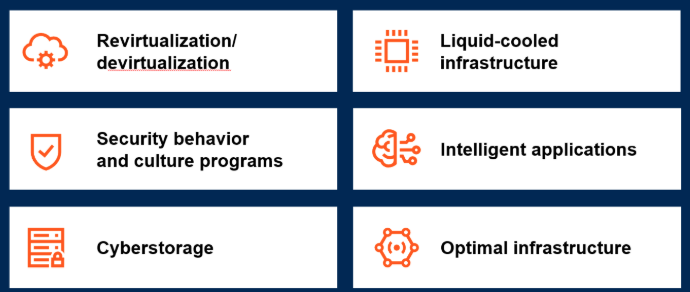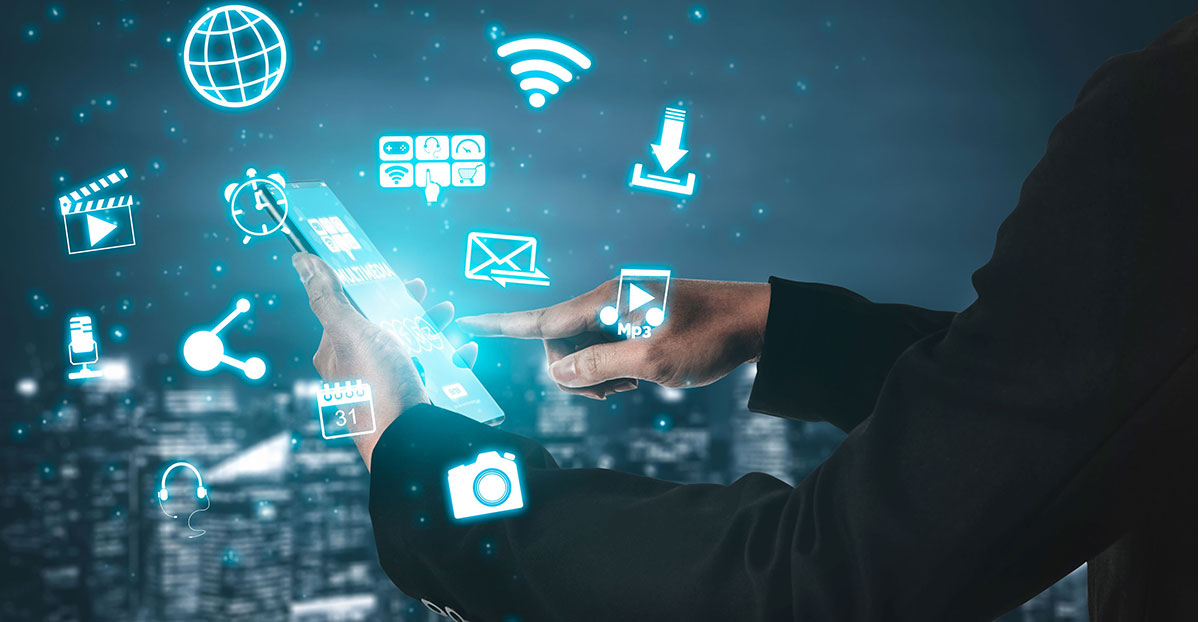Gartner, Inc. highlighted the six trends that will have a significant impact on infrastructure and operations (I&O) for 2025 .
“These trends give the opportunity for I&O leaders to identify future skills requirements and seek insights to help meet implementation requirements,” said Jeffrey Hewitt, Vice President Analyst at Gartner. “They will provide the differentiation needed for enterprises to gain the optimal benefits from their I&O operations in 2025.”
Figure 1: Gartner Top I&O Trends for 2025

Trend No. 1: Revirtualization/devirtualization
The recent license changes for certain vendor-based solutions have forced many I&O teams to re-evaluate their virtualization choices with some moving more to public cloud, some turning to distributed cloud and some moving to private cloud. This involves multiple options beyond just changing hypervisors.
“I&O leaders must inventory all current virtualization implementations and any related interdependencies,” said Hewitt. “Evaluate alternative paths including hypervisors, hyperconvergence, distributed cloud, containerization, private cloud and devirtualization. Identify existing I&O skills and how those need to evolve to support top choices.”
Trend No. 2: Security Behavior and Culture Programs
As the sophistication and variety of attacks increases, security programs must evolve to address behavior and culture to optimize their effectiveness. Security behavior and culture programs (SBCPs) are enterprisewide approaches to minimize cybersecurity incidents associated with employee behavior.
SBCP programs result in improved employee adoption of security controls and reductions in behavior not considered secure. They enable I&O to help support the more effective use of cybersecurity resources by employees.
Trend No. 3: Cyberstorage
Cyberstorage solutions utilize a data harbor made up of data that is fragmented and distributed across multiple storage locations. The fragmented data can be instantly reassembled for use when needed.
Cyberstorage can be a dedicated solution with comprehensive features, a platform-native service offering with integrated solutions, or a collection of stand-alone products that augment storage vendors with cyberprotection capabilities.
“For cyberstorage to be successful, I&O leaders should identify the risks of costly and disruptive storage threats, combined with increasing regulatory and insurance expenses to build a business case for cyberstorage adoption,” said Hewitt.
Trend No. 4: Liquid-cooled Infrastructure
Liquid-cooled infrastructure consists of rear-door heat exchange, immersion and direct-to-chip. It enables I&O to support new chip generations, density and AI requirements, while also providing I&O opportunities to flexibly place infrastructure to support edge use cases.
“Liquid cooling has evolved to move from cooling the broader data center environment to getting closer and even within the infrastructure,” said Hewitt. “Liquid-cooled infrastructure remains niche today in terms of use cases but will become more predominant as next generations of GPUs and CPUs increase in power consumption and heat production.”
Trend No. 5: Intelligent Applications
Generative AI has revealed applications’ potential to operate intelligently, which has created the expectation for intelligent applications. Intelligent applications adapt to their user’s context and intent, thereby reducing digital friction. It can interoperate in pursuit of their own, as well as their users’ intents, by marshaling the appropriate interfaces to external APIs and connected data.
Ultimately, intelligent applications reduce required intervention and interactions on the part of I&O. It also optimizes processes and utilization while reducing resource overhead.
Trend No. 6: Optimal Infrastructure
Optimal infrastructure is when I&O teams place a highly significant emphasis on the best infrastructure choices for a given use case across a range of deployment styles. This approach utilizes a business-based focus so that executives outside of IT can understand why infrastructure choices are made from their perspectives.
“These choices are ultimately aligned with platform engineering adoption,” said Hewitt. “They allow I&O to align infrastructure choices with the business objectives of the overall organization. They also facilitate the support and approval of business unit leaders and C-level executives.”
การ์ทเนอร์ เผย 6 เทรนด์ที่ส่งผลกระทบอย่างมีนัยสำคัญต่อโครงสร้างพื้นฐานและการปฏิบัติการ (หรือ I&O) สำหรับปี 2568
เจฟฟรีย์ ฮิววิตต์ รองประธานนักวิเคราะห์การ์ทเนอร์ กล่าวว่า “แนวโน้มต่าง ๆ เหล่านี้เปิดโอกาสให้ผู้นำ I&O สามารถระบุความต้องการด้านทักษะในอนาคตและค้นหาข้อมูลเชิงลึกเพื่อตอบโจทย์ความต้องการสำหรับการนำไปปฏิบัติใช้ โดยเทคโนโลยีเหล่านี้จะสร้างความแตกต่างที่จำเป็นสำหรับองค์กรเพื่อให้ได้รับประโยชน์สูงสุดจากการปฏิบัติการด้าน I&O ในปี 2568″
ภาพที่ 1: เทรนด์เทคโนโลยีโครงสร้างพื้นฐานและการปฏิบัติการสำคัญในปี 2568 โดยการ์ทเนอร์

เทรนด์ที่ 1: Revirtualization/devirtualization
การเปลี่ยนแปลงใบอนุญาตล่าสุดสำหรับโซลูชันในผู้ขายบางรายได้กดดันให้ทีม I&O หลายทีมต้องประเมินและพิจารณาทางเลือกด้านการทำเวอร์ชวลไลเซชันใหม่ โดยบางส่วนย้ายไปใช้พับลิกคลาวด์มากขึ้น บางส่วนหันไปใช้ดิสทริบิวเต็ดคลาวด์ และบางส่วนย้ายไปใช้ไพรเวทคลาวด์ ซึ่งเกี่ยวข้องกับตัวเลือกหลายอย่างนอกเหนือจากการเปลี่ยนซอฟต์แวร์ที่ช่วยให้ใช้งาน Virtual Machine หลายตัวบนอุปกรณ์เครื่องเดียว หรือที่เรียกว่า ไฮเปอร์ไวเซอร์ (Hypervisors)
“ผู้นำ I&O ต้องสำรวจการใช้งานเวอร์ชวลไลเซชันทั้งหมดในปัจจุบันรวมถึงการพึ่งพาที่เกี่ยวข้องซึ่งกันและกัน อาทิ ประเมินหนทางเลือกต่าง ๆ รวมถึงการหา Hypervisors, Hyperconvergence, Distributed Cloud, Containerization, Private Cloud และ Devirtualization เพื่อระบุทักษะ I&O ที่มีอยู่และวิธีที่จำเป็นต้องพัฒนาเพื่อรองรับตัวเลือกที่ดีที่สุด” ฮิววิตต์กล่าวเพิ่มเติม
เทรนด์ที่ 2: Security Behavior and Culture Programs
เมื่อความซับซ้อนและความหลากหลายของการโจมตีเพิ่มขึ้น โปรแกรมความปลอดภัยต้องพัฒนาเพื่อจัดการกับพฤติกรรมและวัฒนธรรมเพื่อเพิ่มประสิทธิภาพสูงสุด โปรแกรมพฤติกรรมและวัฒนธรรมด้านความปลอดภัย (Security Behavior and Culture Programs หรือ SBCPs) เป็นแนวทางระดับองค์กรเพื่อลดเหตุการณ์ด้านความปลอดภัยทางไซเบอร์ที่เกี่ยวข้องกับพฤติกรรมของพนักงาน
โปรแกรม SBCP ส่งผลให้พนักงานนำการควบคุมความปลอดภัยมาใช้ได้ดีขึ้นและลดพฤติกรรมที่ไม่ปลอดภัย โปรแกรมนี้ช่วยให้ทีม I&O สามารถสนับสนุนการใช้ทรัพยากรด้านความปลอดภัยทางไซเบอร์โดยพนักงานได้อย่างมีประสิทธิภาพมากขึ้น
เทรนด์ที่ 3: Cyberstorage
โซลูชันไซเบอร์สตอเรจใช้คลังข้อมูลที่ประกอบด้วยข้อมูลที่แยกย่อยและกระจัดกระจายอยู่ในหลายตำแหน่งการจัดเก็บ ช่วยให้ข้อมูลย่อยสามารถประกอบกลับเข้าด้วยกันได้ทันทีเมื่อต้องการใช้งาน
ไซเบอร์สตอเรจสามารถเป็นโซลูชันเฉพาะทางที่มีฟีเจอร์ครบครัน บริการแพลตฟอร์มดั้งเดิมที่มีโซลูชันแบบบูรณาการ หรือชุดผลิตภัณฑ์แบบสแตนด์อโลนที่เพิ่มความสามารถด้านการป้องกันทางไซเบอร์ให้กับผู้ขายสตอเรจ
“เพื่อให้ไซเบอร์สตอเรจประสบความสำเร็จ ผู้นำ I&O ควรระบุความเสี่ยงของภัยคุกคามด้านการจัดเก็บข้อมูลที่มีค่าใช้จ่ายสูงและสร้างการหยุดชะงัก ประกอบกับค่าใช้จ่ายด้านกฎระเบียบและการรับประกันที่เพิ่มขึ้น เพื่อสร้างยูสเคสทางธุรกิจสำหรับการนำไซเบอร์สตอเรจมาใช้” ฮิววิตต์กล่าวเพิ่ม
เทรนด์ที่ 4: Liquid-Cooled Infrastructure
โครงสร้างพื้นฐานที่ใช้การระบายความร้อนด้วยของเหลวประกอบด้วยการแลกเปลี่ยนความร้อนแบบประตูหลัง การแช่ และการระบายความร้อนด้วยของเหลวแบบตรงถึงชิป ช่วยให้ระบบสามารถรองรับชิปรุ่นใหม่ ๆ ความหนาแน่น และความต้องการด้าน AI พร้อมทั้งให้โอกาสในการวางโครงสร้างพื้นฐานอย่างยืดหยุ่นเพื่อรองรับการใช้งานรูปแบบใหม่ ๆ
“การระบายความร้อนด้วยของเหลวได้รับการพัฒนามาจากการระบายความร้อนในสภาพแวดล้อมของดาต้าเซ็นเตอร์ที่กว้างขึ้นไปสู่การเข้าใกล้และอยู่ภายในโครงสร้างพื้นฐาน โดยโครงสร้างพื้นฐานที่ใช้การระบายความร้อนด้วยของเหลวยังคงเป็นตลาดเฉพาะกลุ่มในแง่ของยูสเคสการใช้งานในปัจจุบัน แต่จะมีความโดดเด่นมากขึ้นเมื่อ GPU และ CPU รุ่นถัดไปมีการใช้พลังงานและการผลิตความร้อนเพิ่มขึ้น” ฮิววิตต์กล่าวเพิ่ม
เทรนด์ที่ 5: Intelligent Application
Generative AI เผยให้เห็นศักยภาพการทำงานอย่างชาญฉลาดของแอปพลิเคชัน ซึ่งได้สร้างความคาดหวังสำหรับ Intelligent Applications โดยแอปพลิเคชันอัจฉริยะจะปรับตัวเข้ากับบริบทและเจตนาของผู้ใช้ ช่วยลดความขัดแย้งทางดิจิทัล สามารถทำงานร่วมกันเพื่อบรรลุเป้าหมายของตัวเองและผู้ใช้ โดยการจัดการอินเทอร์เฟซที่เหมาะสมไปยัง API ภายนอกและข้อมูลที่เชื่อมต่อ แอปพลิเคชันอัจฉริยะยังช่วยลดการแทรกแซงและการโต้ตอบที่จำเป็นในส่วนของ I&O อีกทั้งยังเพิ่มประสิทธิภาพกระบวนการและการใช้งานในขณะที่ลดค่าโสหุ้ยด้านทรัพยากร
เทรนด์ที่ 6: Optimal Infrastructure
โครงสร้างพื้นฐานที่เหมาะสมที่สุดคือเมื่อทีม I&O ให้ความสำคัญอย่างมากกับตัวเลือกโครงสร้างพื้นฐานที่ดีที่สุดสำหรับยูสเคสการใช้งานที่กำหนดในรูปแบบการปรับใช้ที่หลากหลาย แนวทางนี้ใช้การมุ่งเน้นที่อิงกับธุรกิจเพื่อให้ผู้บริหารที่ไม่ใช่ด้าน IT สามารถเข้าใจได้ว่าทำไมจึงเลือกโครงสร้างพื้นฐานจากมุมมองของพวกเขา
“ตัวเลือกเหล่านี้สอดคล้องกับการนำแพลตฟอร์มเอนจิเนียริ่งมาใช้ในท้ายที่สุด พวกเขาช่วยให้ I&O สามารถจัดแนวโครงสร้างพื้นฐานให้สอดคล้องกับวัตถุประสงค์ทางธุรกิจขององค์กรในภาพรวม นอกจากนี้ยังช่วยอำนวยความสะดวกในการสนับสนุนและการอนุมัติจากผู้นำธุรกิจและผู้บริหารระดับสูง” ฮิววิตต์กล่าวทิ้งท้าย

